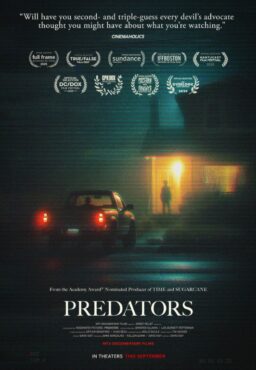STOCKHOLM – Even when he is not behind a camera, Bo Widerberg is a director, concerned with the arrangements of things. He takes a dinner knife and draws boundaries on the table cloth, and then he divides the wine glasses and bread plates into groups related somehow to the lines he has drawn.
There is no pattern to this. But that does not matter because dinner is over anyway, and Widerberg does not notice that his hands are occupied. He is talking with great energy and in rapid English about his new film, “Elvira Madigan.”
Widerberg, at 37, has directed four other films, but this is the first to have success overseas. Within Sweden, he is considered the best of the young directors, but outside he has always had to labor in the shadow of Ingmar Bergman‘s international reputation.
Widerberg’s “Raven's End” (1965), a success at the New York Film Festival and even an Oscar nominee, was never distributed nationally in the U.S. But “Elvira Madigan” has changed the pattern and may establish Widerberg as a hero of younger filmgoers, who identify more quickly with Godard’s brisk irreverence than with Bergman’s theology. After great success in New York, it will open its second U.S. engagement at the Playboy Theater on Friday.
Elvira Madigan, as every Swedish school child can tell you, was a beautiful young tightrope performer who, in the summer of 1899, abandoned her family circus to run away with Count Sixten Sparre. He, in turn, deserted from the Army and left behind a wife and two children. For a summer they lived happily, and when their funds were exhausted in the autumn, they went on a final picnic and committed suicide.
Their story has been close to the hearts of the Swedes ever since and there is a famous ballad about Elvira:
She was dainty, sweet and tender,
She was pretty as a jewel;
Neat her foot, her waist was slender,
But, alas, her fate was cruel.
The story of the young lovers was first made into a Swedish movie 20 years ago. But Widerberg wanted to tell it in modem terms, and he has. Like “Bonnie and Clyde” (which, curiously enough, it resembles very much), “Elvira Madigan” works by juxtaposing visual beauty and temporary happiness with a strong sense of approaching tragedy.
For Elvira, Widerberg wanted an unknown actress, and discovered Pia Degermark, a 16-year-old schoolgirl, in a newspaper picture showing her dancing with Sweden’s crown prince. (“Traditionally it’s supposed to work the other way around,” Widerberg observed, “and it’s the crown prince who’s supposed to discover the girl in the paper.”)
Miss Degermark is a fragile blond who looks both worldly enough to have a love affair and naive enough to have an impossibly idealistic one. Widerberg directed her mostly by talking over each scene thoroughly and then shooting it without rehearsal, and for her first film role, Miss Degermark won this year’s Best Actress Award at Cannes.
For Sixten, Widerberg choose Thommy Berggren, a well known Stockholm stage actor who has appeared in all his films. Since the cast for almost all the scenes consisted only of the two lovers, and since the legend was so well established that a script seemed unnecessary, Widerberg decided to use a small production crew and simply go out on location into Sweden and Denmark, improvising the scenes more or less in order as locations suggested themselves and shooting only with natural light.
His method works beautifully. We first see the lovers through the eyes of a little girl (Widerberg’s daughter) who is chasing butterflies through a meadow when she stops, astonished by the sight of the couple. Elvira takes Sixten’s jacket and removes the brass Army buttons and gold braid from it, and not a word is necessary.
In other scenes, the lovers dip wild berries into a bucket of cream, drift slowly in a rowboat, make love in the afternoon and resolutely ignore the reality of their situation. When one of Sixten’s friends tracks the couple down and reminds him of his family, the lovers argue that there are times at which love is really the only thing that matters. The only thing. When the suicide comes at the end, it is consistent with their romantic monomania.
“My method was to allow Pia and Thommy all the time they wanted for each scene,” Widerberg said. “They could take long pauses before each line. Then I edited the pauses out of the film without losing the clear sense that each scene was played as a whole. I also wanted them to experience personally some of the things that were happening to the characters they were playing.”
Miss Degermark, who was also interviewed, remembered with a smile her introduction to Widerberg’s theory. “On the first day of shooting, we were to do the love scene,” she said. “I had not acted before, of course, and I was nervous. More importantly, Bo believed we could not do a convincing love scene if we, as actors, were complete strangers. So he told Thommy and me to go off into the woods and kiss for half an hour, to develop a certain intimacy.”
Widerberg smiled and said, “The story is true, but perhaps it should not be told. Stories like that never sound just right. But how could I expect them to kiss in front of the cameras if they were completely unknown to each other?”
At a time when most Hollywood movies require a production crew of more than 150 persons, Widerberg made his entire film with only eight people: the two actors, himself and five technicians.
“We used a hand-held camera a great deal of the time, trying for an effect of realism,” he said. “In fact, I was trying to pretend, in a way, that we were a television crew and that we were ‘covering’ the love story as if it were a news event. I know that sounds ridiculous.”
Despite its low production cost, “Elvira Madigan” is a film of great beauty. Newsweek called it the most beautiful film ever made, and so taken was Bosley Crowther of the New York Times that he has allowed his review to be read, in toto, as the film’s “coming attraction.”
Emily Genauer of Newsday has discovered that many of Widerberg’s scenes are composed as copies of familiar paintings by the French impressionists. Among the paintings she has “found” in the film are Seurat’s “Sunday at the Grand Jatte,” Renoir’s “Boating Party at Chatou” and in one of the picnic scenes, Manet’s “Luncheon on the Grass.” The musical score is also immediately familiar; it is Mozart’s Piano Concerto No. 21.
“We did all that deliberately,” Widerberg said. “We had a very stiff surface created by the costumes, the nostalgia and a plot told in a ballad every child can sing by heart. So we began by emphasizing the surface and playing up the romance. Here is the story of two young people who abandon all responsibility and live entirely for the moment. And they are happy, for the moment. But gradually the surface begins to break, and underneath it the audience begins to sense a cold wind blowing.”
Although he had not seen “Bonnie and Clyde” when he was filming, Widerberg agreed that his film shares its irony. “It is an irony based on time,” he said. “To begin with, the audience must know the story. It is important that American audiences know who Bonnie and Clyde were, and what end they came to, just as Swedes know of Elvira and Sixten. Then, while the characters live entirely in the moment, the story itself rushes to a tragic conclusion. Death is waiting there at the end, and its presence colors all the happy moments that come before.”











